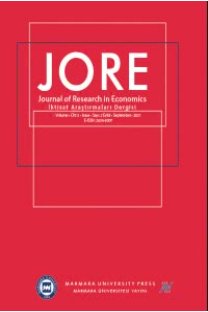INFLATION AND MONTHLY STOCK RETURNS RELATIONSHIP IN THE AIRLINE MARKET
INFLATION AND MONTHLY STOCK RETURNS RELATIONSHIP IN THE AIRLINE MARKET
Airlines, Inflation, Fourier Analysis Toda-Yamamoto causality test.,
___
- Abdi, Y., Li, X., & Càmara‐Turull, X. (2022). How financial performance influences investment in sustainable development initiatives in the airline industry: The moderation role of state‐ownership. Sustainable Development.
- Amihud, Y. (1996). Unexpected inflation and stock returns revisited—evidence from Israel. Journal of Money, Credit and Banking, 28(1), 22-33.
- Baker, D., Merkert, R., & Kamruzzaman, M. (2015). Regional aviation and economic growth: cointegration and causality analysis in Australia. Journal of Transport Geography, 43, 140-150.
- Balduzzi, P. (1995). Stock returns, inflation, and the ‘proxy hypothesis’: A new look at the data. Economics Letters, 48(1), 47-53.
- Becker, R., Enders, W., & Lee, J. (2006). A stationarity test in the presence of an unknown number of smooth breaks. Journal of Time Series Analysis, 27(3), 381-409.
- Bui, T. N. (2019). Inflation and Stock Index: Evidence from Vietnam. Journal of Management Information & Decision Sciences, 22(4).
- Button, K., & Porta, F. (2022). The role of strategic airline alliances in Africa. Journal of Transport Economics and Policy (JTEP), 56(2), 272-294.
- Calzada, J., Fageda, X., & Safronov, R. (2022). How do global airline alliances affect flight frequency? Evidence from Russia. Journal of Air Transport Management, 98, 102156.
- Christopoulos, D. K., & León-Ledesma, M. A. (2010). Smooth breaks and non-linear mean reversion: Post- Bretton Woods real exchange rates. Journal of International Money and Finance, 29(6), 1076-1093.
- Eldomiaty, T., Saeed, Y., Hammam, R., & AboulSoud, S. (2020). The associations between stock prices, inflation rates, interest rates are still persistent: Empirical evidence from stock duration model. Journal of Economics, Finance and Administrative Science, 25(49), 149-161.
- Fama, E. F. (1981). Stock returns, real activity, inflation, and money. The American Economic Review, 71(4), 545-565.
- Fernandez, V. (2022). Environmental management: Implications for business performance, innovation, and financing. Technological Forecasting and Social Change, 182, 121797.
- Hakim, M. M., & Merkert, R. (2016). The causal relationship between air transport and economic growth: Empirical evidence from South Asia. Journal of Transport Geography, 56, 120-127.
- Hanson, D., Delibasi, T. T., Gatti, M., & Cohen, S. (2022). How do changes in economic activity affect air passenger traffic? The use of state-dependent income elasticities to improve aviation forecasts. Journal of Air Transport Management, 98, 102147.
- Hepsağ, A. (2022). Ekonometrik zaman serileri analizlerinde güncel yöntemler (Winrats Uygulamali). İstanbul: Der Yayınları
- Ivaldi, M., Petrova, M., & Urdanoz, M. (2022). Airline cooperation effects on airfare distribution: An auction-model-based approach. Transport Policy, 115, 239-250.
- Jamuna, D. (2016). Inflation and its impact on Indian economy. International Journal of Application or Innovation in Engineering & Management (Ijaiem) April.
- Li, L., Narayan, P. K., & Zheng, X. (2010). An analysis of inflation and stock returns for the UK. Journal of international financial markets, institutions and money, 20(5), 519-532.
- Pearce, D. K., & Roley, V. V. (1988). Firm characteristics, unanticipated inflation, and stock returns. The Journal of Finance, 43(4), 965-981.
- Peng, I. C., & Lu, H. A. (2022). Coopetition effects among global airline alliances for selected Asian airports. Journal of Air Transport Management, 101, 102193.
- Pot, F. J., & Koster, S. (2022). Small airports: Runways to regional economic growth? Journal of Transport Geography, 98, 103262.
- Raghoo, P., & Surroop, D. (2020). Price and income elasticities of oil demand in Mauritius: An empirical analysis using cointegration method. Energy Policy, 140, 111400.
- Seçilmiş, N., & Koç, A. (2016). Economic factors affecting aviation demand: Practice of EU countries. Актуальні проблеми економіки, (5), 412-420.
- Tsong, C. C., Lee, C. F., Tsai, L. J., & Hu, T. C. (2016). The Fourier approximation and testing for the null of cointegration. Empirical Economics, 51(3), 1085-1113.
- Tsui, W. H. K., Fu, X., Yin, C., & Zhang, H. (2021). Hong Kong’s aviation and tourism growth-An empirical investigation. Journal of Air Transport Management, 93, 102036.
- Winzar, H., Baumann, C., Soboleva, A., Park, S. H., & Pitt, D. (2022). Competitive Productivity (CP) as an emergent phenomenon: Methods for modelling micro, meso, and macro levels. International Journal of Hospitality Management, 105, 103252.
- Yamaguchi, K. (2022). Productivity impact of government-led bailout of Japan Airlines. Asian Transport Studies, 8, 100064.
- Yen, B. T., & Li, J. S. (2022). Route-based performance evaluation for airlines–A metafrontier data envelopment analysis approach. Transportation Research Part E: Logistics and Transportation Review, 162, 102748.
- Zhang, X., Chen, X., Fang, Z., Zhu, Y., & Liang, J. (2022). Investment in energy resources, natural resources and environment: Evidence from China. Resources Policy, 76, 102707.
- ISSN: 2636-8307
- Başlangıç: 2016
- Yayıncı: Marmara Üniversitesi
OPTIMAL SIZE OF TURKIYE’S GROWING CITY: TEKİRDAĞ
Onyebuchi Henry CHİOGOR, Gylych JELILOV, Olugbenga Omotayo ALABI
Tamerlan MASHADİHASANLİ, Haluk ZÜLFİKAR
THE UNEXPECTED SHORTFALL: AN ALTERNATIVE RISK MEASURE
INFLATION AND MONTHLY STOCK RETURNS RELATIONSHIP IN THE AIRLINE MARKET
